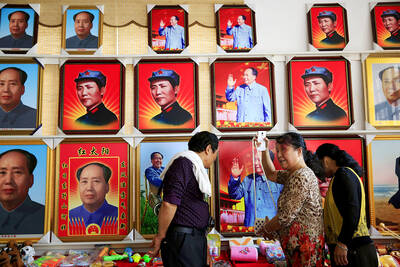Exactly one year to the day a predawn fire destroyed the Cloud Gate Dance Theatre’s (雲門舞集) home in Pali, Taipei County, founder Lin Hwai-min (林懷民) stood in front of the Taipei Story House on Wednesday, a huge banner with dancer Chiu I-wen (邱怡文) leaping in the air hanging behind him. Lin was there to open an exhibition that provides a behind-the-scenes look at one of the nation’s cultural treasures.
“Actually, this exhibit was supposed to open last September for the [company’s] 35th anniversary, but then there was the fire and then the anniversary was gone, so we decided to do it this year. But we did it lighter,” Lin said.
“I insisted the photos have a feeling of light,” he said, taking a deep breath and throwing open his arms, “of openness.”
But to get to the light, visitors have to pass through darkness. A burned shipping container used at Cloud Gate’s old Pali home sits to the right of the building’s front door. A small wooden walkway takes you into the container to view a video of firefighters battling the blaze and news coverage of it.
Taipei Story House’s entryway has been painted eggshell blue, with dancers suspended in mid-air (Chiu again on the right wall and Huang Pei-hua (黃珮華)on the left). On the back wall is a floor-to-ceiling photo of the original troupe.
In the first room, titled “Life Under the Tin Roof,” Cloud Gate archivist Chen Pin-hsiu (陳品秀) has recreated a slice of the main Pali studio. The black mylar floor has tape rehearsal markings, a ballet barre stands in front of a mirrored wall, pinned on a corkboard are weekly work schedules for the company from the week prior to and after the fire, alongside a photocopy of a Village Voice review. Resting on the fireplace mantelpiece is a collection of charred coffee mugs and chopsticks salvaged from the kitchen. Dancers’ personal belongings dot the room.
Exhibition-goers should spend most of their time in the second room, a corridor really, where 16 video monitors of varying sizes have been placed along the two walls. Each monitor shows footage of a different aspect of life for the dancers of the first and second companies: performing at Pina Bausch’s International Dance Festival in Germany, performing at hospitals and schools around Taiwan, riding on a bus while on tour, rehearsals and daily classes.
The third room is just plain fun, offering everyone the chance to feel like a Cloud Gate dancer or stagehand. The walls and floor are pitch-black, there are several small fans and thousands of pink cloth flower petals like those used in last year’s Whisper of Flowers. Feel free to dance around throwing armfuls of petals in the air.
Upstairs is a small display of photos: a close-up of a dancer’s taped and bandaged feet, rain-soaked audience members at an outdoor performance. Many of the images were taken by photographer Liu Chen-hsiang (劉振祥), who recently published a book titled In Between The Moments — Cloud Gate: In a Photographer’s Memory.
In the last room, titled “Confronting the Ocean,” is a video recounting the tale of the Pali blaze and the company’s ongoing struggle to rebuild itself and create a new home at the site of the former Central Radio Station in Tamsui.
The Taipei Story House is a tiny place, but the Cloud Gate troupe has maximized its potential.
As part of the exhibition, there will be a lecture series from 7pm to 8:30pm on three Saturdays. Lin will speak on March 21, writer Yang Chao (楊照) on April 11 and Cloud Gate 2 manager Liao Yung-wei (廖詠葳) on May 16.
There is also a weekend concert series that gets underway tomorrow and runs until April 26th, featuring traditional flute and erhu (二胡) music. Friday night concerts will be from 7:30 to 9pm, while Saturday and Sundays concerts will be from 3pm to 5pm. A complete listing of the events can be found in the Taipei Story House’s calendar brochure or its Chinese-language Web site (www.storyhouse.com.tw); unfortunately the English-language site hasn’t been updated in more than a year.

Many people noticed the flood of pro-China propaganda across a number of venues in recent weeks that looks like a coordinated assault on US Taiwan policy. It does look like an effort intended to influence the US before the meeting between US President Donald Trump and Chinese dictator Xi Jinping (習近平) over the weekend. Jennifer Kavanagh’s piece in the New York Times in September appears to be the opening strike of the current campaign. She followed up last week in the Lowy Interpreter, blaming the US for causing the PRC to escalate in the Philippines and Taiwan, saying that as

Taiwan can often feel woefully behind on global trends, from fashion to food, and influences can sometimes feel like the last on the metaphorical bandwagon. In the West, suddenly every burger is being smashed and honey has become “hot” and we’re all drinking orange wine. But it took a good while for a smash burger in Taipei to come across my radar. For the uninitiated, a smash burger is, well, a normal burger patty but smashed flat. Originally, I didn’t understand. Surely the best part of a burger is the thick patty with all the juiciness of the beef, the

This year’s Miss Universe in Thailand has been marred by ugly drama, with allegations of an insult to a beauty queen’s intellect, a walkout by pageant contestants and a tearful tantrum by the host. More than 120 women from across the world have gathered in Thailand, vying to be crowned Miss Universe in a contest considered one of the “big four” of global beauty pageants. But the runup has been dominated by the off-stage antics of the coiffed contestants and their Thai hosts, escalating into a feminist firestorm drawing the attention of Mexico’s president. On Tuesday, Mexican delegate Fatima Bosch staged a

The ultimate goal of the Chinese Communist Party (CCP) is the total and overwhelming domination of everything within the sphere of what it considers China and deems as theirs. All decision-making by the CCP must be understood through that lens. Any decision made is to entrench — or ideally expand that power. They are fiercely hostile to anything that weakens or compromises their control of “China.” By design, they will stop at nothing to ensure that there is no distinction between the CCP and the Chinese nation, people, culture, civilization, religion, economy, property, military or government — they are all subsidiary